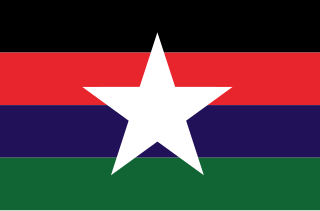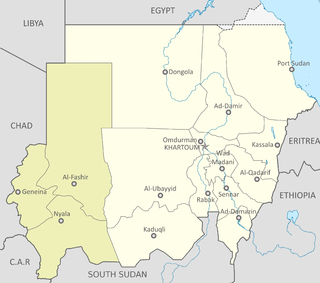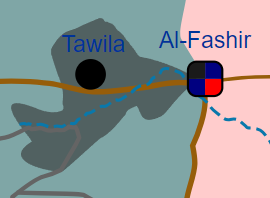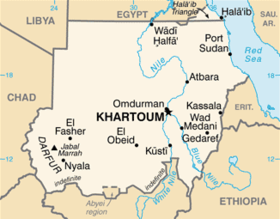
Darfur is a region of western Sudan. Dār is an Arabic word meaning "home [of]" – the region was named Dardaju while ruled by the Daju, who migrated from Meroë c. 350 AD, and it was renamed Dartunjur when the Tunjur ruled the area. Darfur was an independent sultanate for several hundred years until 1874, when it fell to the Sudanese warlord Rabih az-Zubayr. The region was later invaded and incorporated into Sudan by Anglo-Egyptian forces in 1916. As an administrative region, Darfur is divided into five federal states: Central Darfur, East Darfur, North Darfur, South Darfur and West Darfur. Because of the War in Darfur between Sudanese government forces and the indigenous population, the region has been in a state of humanitarian emergency and genocide since 2003. The factors include religious and ethnic rivalry, and the rivalry between farmers and herders.
The Kujargé language is spoken in seven villages in eastern Chad near Jebel Mirra, and in villages scattered along the lower Wadi Salih and Wadi Azum in Darfur, Sudan. It is estimated to have about 1000 speakers.

Geneina is a city in West Darfur, part of the dar Masalit region, in Sudan. It joined British Sudan at the end of 1919 through the Gilani Agreement, signed between the Masalit Sultanate and the United Kingdom, according to which it became a territory.

The Sudan Liberation Movement/Army is a Sudanese rebel group active in Darfur, Sudan. It was founded as the Darfur Liberation Front by members of three indigenous ethnic groups in Darfur: the Fur, the Zaghawa, and the Masalit, among whom were the leaders Abdul Wahid al Nur of the Fur and Minni Minnawi of the Zaghawa.

Throughout its history, Darfur has been the home to several cultures and kingdoms, such as the Daju and Tunjur kingdoms. The recorded history of Darfur begins in the seventeenth century, with the foundation of the Fur Sultanate by the Keira dynasty. In 1875, the Anglo-Egyptian condominium in Khartoum ended the dynasty. The British allowed Darfur a measure of autonomy until formal annexation in 1916. However, the region remained underdeveloped through the period of colonial rule and after independence in 1956. The majority of national resources were directed toward the riverine Arabs clustered along the Nile near Khartoum. This pattern of structural inequality and overly underdevelopment resulted in increasing restiveness among Darfuris. The influence of regional geopolitics and war by proxy, coupled with economic hardship and environmental degradation, from soon after independence led to sporadic armed resistance from the mid-1980s. The continued violence culminated in an armed resistance movement around 2003.
The Daju people are a group of seven distinct ethnicities speaking related languages living on both sides of the Chad-Sudan border and in the Nuba Mountains. Separated by distance and speaking different languages, at present, they generally have little cultural affinity to each other.

Kalma is a relocation camp in the Darfur region of Sudan. It is located 17 kilometers outside of Nyala, Sudan. It is estimated that there were over 90,000 residents in the camp in 2007. Most, if not all, of the residents are there because of the violence caused by the Darfur conflict.
The Dar Fur Daju are an ethnic group in the Sudan. They are one of seven distinct ethnicities comprising the Daju people. They speak the Nyala language. They live in Southern Darfur in the Sudan in the Daju Hills 40 km northeast of Nyala - although most of this population has fled to Chad as a result of the Darfur Conflict. There is also a small population of Dar Fur Daju near the city of Lagowa in the Nuba Hills. Their total population numbers 98,000 (2017). They are mostly Muslim.
The Kujarke people are a little-known ethnic group of the Ouaddaï Region in eastern Chad and South Darfur, Sudan. They speak Kujargé, a divergent, unclassified Afro-Asiatic language. Their current population and locations are unknown due to the war in Darfur. Furthermore, they have not been previously recorded as a separate ethnic group by any government or foreign aid organization.
The following lists events during 2023 in the Republic of the Sudan.

A civil war between two rival factions of the military government of Sudan, the Sudanese Armed Forces (SAF) under Abdel Fattah al-Burhan, and the paramilitary Rapid Support Forces (RSF) under Hemedti, began during Ramadan on 15 April 2023. Fighting has been concentrated around the capital city of Khartoum and the Darfur region. As of 21 January 2024, at least 13,000–15,000 people had been killed and 33,000 others were injured. As of 29 December 2023, over 5.8 million were internally displaced and more than 1.5 million others had fled the country as refugees, and many civilians in Darfur have been reported dead as part of the 2023 Masalit massacres.

The Battle of Geneina, also known as the Geneina massacre, was a battle for control of Geneina, the capital of West Darfur in Sudan, between the paramilitary Rapid Support Forces (RSF) and the Sudanese Armed Forces (SAF). By 25 April 2023, fighting intensified and devolved along tribal lines, with Masalit and non-Arab peoples supporting the SAF and the aligned Joint Darfur Force—consisting of former rebel groups including the Sudan Liberation Movement/Army and the Justice and Equality Movement—against the RSF and allied Arab militias.
The following is a timeline of the War in Sudan (2023-present).
The Battle of Nyala was a battle for control of Nyala, the capital of South Darfur in Sudan, between the paramilitary Rapid Support Forces (RSF), and the Sudanese Armed Forces during the ongoing Darfur campaign. The first battle occurred between 15 and 20 April 2023, during which hundreds were reported dead. A civilian-brokered ceasefire paused the fighting by April 20. Sporadic clashes broke out between May and July. In August 2023, the RSF launched an offensive on the city. The SAF launched air campaigns against the RSF in Nyala, with many civilian casualties in Taiba and El Matar. In late September, the RSF besieged the headquarters the SAF's 16th Infantry Division headquarters, capturing it on October 26.
The humanitarian crisis following the 2023 Sudan conflict was further exacerbated by the violence occurring during a period of high temperatures, drought and the conflict starting during the latter part of the fasting month of Ramadan. Most residents were unable to venture outside of their homes to obtain food and supplies for fear of getting caught in the crossfire. A doctors' group said that hospitals remained understaffed and were running low on supplies as wounded people streamed in. The World Health Organization recorded around 26 attacks on healthcare facilities, some of which resulted in casualties among medical workers and civilians. The Sudanese Doctors' Union said more than two-thirds of hospitals in conflict areas were out of service with 32 forcibly evacuated by soldiers or caught in the crossfire. The United Nations reported that shortages of basic goods, such as food, water, medicines and fuel have become "extremely acute". The delivery of badly-needed remittances from overseas migrant workers was also halted after Western Union announced it was closing all operations in Sudan until further notice.

The Battle of El Fasher is an ongoing battle for control of the town of El Fasher in North Darfur during the 2023 Sudan conflict. The first battle for the city took place between April 15 and April 20, and resulted in a ceasefire that held until May 12. Clashes broke out again between May 12 and 29, and ended with a more stable ceasefire that lasted until August. By September, the city had become a haven for refugees across the region, and was also suffering from food and water shortages.

Khamis Abdullah Abakar also known as Abdallah Abakar was a Sudanese politician, activist and former army commander who served as the Governor of West Darfur from 2021 to 2023.
Sirba is a town in West Darfur, Sudan. It lies approximately 23 kilometres (14 mi) north of El Geneina, which is the capital of West Darfur. The town has been subjected to attacks and violence by the Rapid Support Forces (RSF) and allied gunmen during the ongoing conflict in the region.

The war in Sudan, which started on 15 April 2023, has seen a widespread of war crimes committed by both the Sudanese Armed Forces (SAF) and the Rapid Support Forces (RSF), with the RSF being singled out by the Human Rights Watch, and the United Kingdom and United States governments for committing crimes against humanity. The conflict was marked by heavy indiscriminate shelling, gunfire, and airstrikes on markets and populated residential neighbourhoods, causing a high number of fatalities. Hospitals were targeted during aerial bombings and artillery fire, and medical supplies were looted. These attacks severely impacted Sudan’s healthcare system, disrupting medical services and leaving the majority of the hospitals in conflict-affected states out of service. The UN declared Sudan the most dangerous country for humanitarian workers after South Sudan.
The Darfur Joint Protection Force, or more simply the Joint Darfur Force/Joint Force, is a neutral peacekeeping force that was set up during the Battle of El Fasher to protect civilians during the War in Sudan (2023). It was formed on 27 April 2023 by four former rebel groups and signatures of the Juba peace agreement. The participating groups are SLM-Minawi, the Justice and Equality Movement, the Sudanese Alliance, and the Gathering of Sudan Liberation Forces. It is currently led by Darfur Region Governor Minni Minawi.













